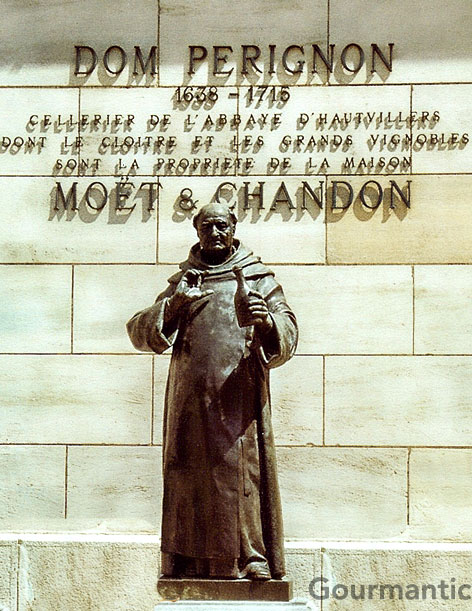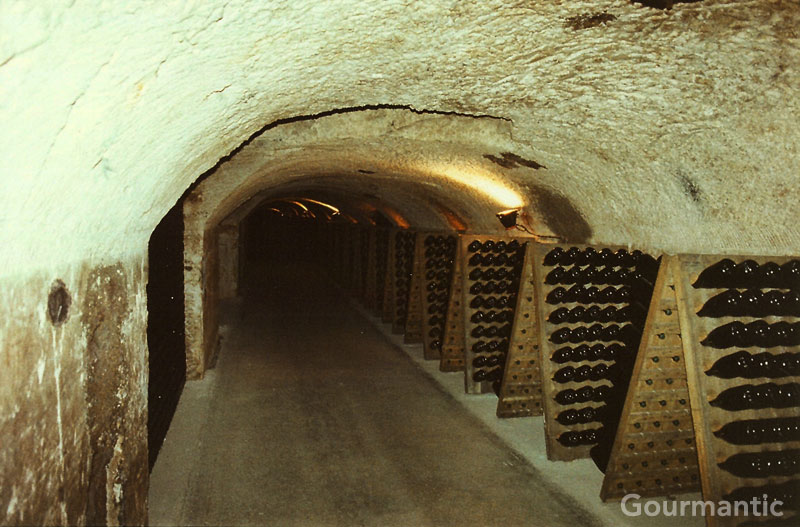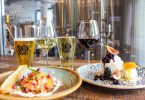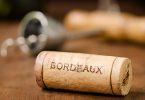
he visit to Fontainebleau was brief. The reason being we have a date with an old monk in Epernay. We continue along the N6 to Melun past Crécy La Chapelle on N36 through smaller picturesque departmental roads before we join the N3. In between vast plains and valleys, we pass little villages that seem void of people.
On the map, I see the towns of Meaux and La Ferté-sous-Jouarre are along the N3. We approach Chateau Thierry, Jean de la Fontaine’s hometown, with a picture sign of le corbeau et le renard denoting his famous fable. We consider stopping for a quick look around but Epernay is another 50 km away and we chose not to take the autoroute to avoid the traffic out of Paris.
The thought of drinking Champagne on an empty stomach has little appeal. We stop in Dormans for a baguette, a piece of tête de Moine cheese and Brie de Meaux that has its own A.O.C from the town we just passed. We lunch en route for the last time before we arrive in Epernay, the capital of Champagne.
Founded in the fifth century, Epernay was a fortified town that withstood historical events and had to be rebuilt 25 times. From the eighteenth century, the masterful techniques of Champagne making and the nineteenth century wine merchants have contributed to its wealth. In the nineteenth century, more than one hundred kilometres of tunnel were dug, linking a unique system of cellars hewn out of chalk.
The stately Avenue de Champagne is home to prestigious nineteenth century Champagne mansions such as Pol Roger, Perrier Jouet and Moët et Chandon, the latter being our destination.

A statue of Dom Pierre Perignon welcomes us in the car park. The Benedictine monk, 1639-1715, was a cellarer of the Abbey of Hautvilliers and perfected methods of making Champagne by combining wines from a great number of different growths to produce a balanced cuvée.
From the moment we enter the reception area of Moët et Chandon and the greetings by the hostesses, we can see that they are well-equipped to receive visitors. We study the various sized bottles of Champagne on display in glass enclosures and look at historical information. The house boasts famous visitors with names such as Napoleon I, the Duke of Wellington, Louis-Napoleon Bonaparte, Carl Gustaf, the Queen Mother of the United Kingdom and Prince Rainier III of Monaco.

Claude Moët, born in 1683, lived in Cumieres and cultivated his vines in the Marne Valley. In 1743, he founded the house of Moët that he passed on to his son and later his grandson Jean Remy. After the French Revolution, he acquired the Abbey of Hautvilliers and its vineyards. In 1832, he handed it over to his son Victor Moet and his son in law Pierre-Gabriel Chandon and the firm became Moët et Chandon. They are now part of the Moët Hennessy Louis Vuitton group.
The vineyards, occupying nearly 1250 hectares produce Pinot Noir from the Montagne de Reims, Pinot Meunier from the Vallee de la Marne and Chardonnay from the Cote des Blancs – all in premier and grand cru villages.
Our host arrives and points out to an audio-visual presentation on the harvest and pressing of the grapes. We learn that the grapes are harvested between late September and mid October, sorted if necessary then transported to the press houses. Traditional presses are used to separate the juice from the pulp without taking colour from the skins. The juice from the pulp then goes into cuvées de debourbage beneath the presses where it remains for a few hours until any solids settle down. Only the first pressings are used by Moët et Chandon as they yield higher quality grape juice which is transferred into oak casks or stainless steel vats. The first fermentation known as le brouillage takes place at 20 deg C for several weeks as the juice becomes wine. This is cooled before being racked to remove dry deposits.

Our host leads us down a few steps to the dark and cool caves that hold an enormous wealth. He explains that a special cuvee is prepared by a chef de cave by blending new wines from a great number of growths of the three different grapes mentioned earlier. The mixture is tasted and older reserve wine is added.
In the methode champenoise, a small amount of liqueur de tirage, a mixture of cane sugar and yeast enzymes dissolved in still wine, is added before the wine is bottled. The action of the yeast feeding on the sugar causes a slow second fermentation producing carbon dioxide which dissolves in the wine causing the fine bubbles. This is called the prise de mousse. The bottles remain sur lattes to age slowly and gently in the dark coolness of the vast cellars. Stringy mould covers the walls, ceilings and bottles and as we move further along, the temperature drops suddenly.
Another by-product of the methode champenoise is the formation of a fine sediment of dead yeast and other solids that need to be removed. This calls for the process of remuage. The bottles are placed sur pointe, neck downwards, in slanted wooden racks known as pupitres. Daily, for several months, remueurs give each bottle a sharp and gradual turn causing the sediment to slide into the neck of the bottle and rest on the cork. By that stage the bottles are almost in a vertical position. They are stacked sur les pointes, en masse, with neck downwards. The length of which they remain in that position depends on the vintage until the sediment is removed by a process known as the degorgement. The neck bottles are placed in a freezing solution, the sediment is trapped into a frozen block and is expelled mechanically. The bottles are topped up with a small quantity os cane sugar dissolved in wine giving the cuvée a preference of a brut or dry, doux or sweet , or demi-sec slightly sweet wine. The bottles are sealed with a cork and rest in the cellars until they are dressed and labelled.

After all that mental concentration we are ready for refreshment. It comes in the form of a glass of Champagne, unfortunately not a Dom Perignon, near a water fountain of champagne glasses. What follows is a brief tour of a museum depicting the history of the company.
Feeling a little more enlightened, we decide to visit other champagne houses but once we check at the office of tourism, they inform us that they will be closing very soon. There is no point in visiting Reims for Grandes Marques such as G.H. Mumm, renowned for its distinctive label of the Cordon Rouge; Pommery for its impressive caves decorated with chalk carvings depicting champenoise scenes; Taitinger, reputed fro its special cuvees; Veuve Clicquot Ponsardin, widowed at age 27 who ran the business and perfected the art of remuage and of course Bollinger in the town of Ay, James Bond’s favourite Champagne distinguished for its rare deluxe Bollinger RD, récemment dégorgé, full of flavour from the extensive ageing of the bottle sediment.

The region of Champagne is also renowned for other types of wines. The Blanc des Blancs is made exclusively from Chardonnay grapes producing a light and elegant wine. The Coteaux Champenois are the still wines of Champagne, available in red and white varieties having their own A.O.C. Marc de Champagne is a potent spirit distilled from grape skins, residue and pips. Fine Marne is a grape brandy distilled from the local wine and aged in oak casks. Ratafia is a local aperitif, drunk chilled, made from unfermented juice of grapes and aged in casks for a year, akin to Pineau des Charentes. Unfortunately we did not have a chance to sample all these.
We farewell Epernay and drive on the D386 towards A4. We have reached the end of our Tour de France as we head towards Paris. No more folding and unfolding maps, translating road signs, deciding which direction to take and attempting to videotape scenery while Mr G asks for translations and directions. No more driving for Mr G, to whom I will always be grateful for achieving an outstanding task that required tremendous concentration, one that I was too afraid to do.
Our driving experience has been illuminating. We experienced new speed limits, just to keep up with traffic on autoroutes. Overtaking “slow” vehicles was, at times, life-threatening. Mr G would check in the rear view mirror then overtake when all was clear. During those seconds, a car would appear from nowhere flying at 220 km/hr and starts to tail him. He cleared the way fast.
The French may love their speed but they are road wise. On various occasions, slow moving trucks and tractors have ceded passage and cyclists have been considerate of motorists. At the various péages, toll collectors smiled as they said a warm bonjour monsieur, which made parting with money a happy task. French roads are kept in immaculate condition and in constant upgrading. As for the car, our Renault 19, it played a major part in making our Tour de France safe and comfortable.
The uncongested A4 takes us past Marne la Vallée, the site of Eurodisney, past glorious chateaux and onto the peripherique leading to Aéroport Charles de Gaulle at Roissy. With each kilometre, my heartbeat quickens. In a few minutes, I will be realising my lifelong dream. I will be in Paris for the first time.
We take a few wrong exits, for old times’ sake then reach Terminal 2. We bid farewell to our Renault and hand the keys to the Avis desk. We both change into something less casual and hop in a taxi parisien.
Mr G takes my hand just as my pulse begins to quicken. The next adventure is about to begin.
Paris m’attend. Paris is waiting.
Le Tour de France Gourmantic series has concluded.
‘Le Tour de France Gourmantic’ series is the story of a young couple from Australia who took to the French roads on a whirlwind Tour of France back when the internet wasn’t at everyone’s fingertips, phones were still attached to sockets, GPS was an unfamiliar acronym, digital cameras were a pipe dream and the Euro hadn’t replaced French Francs. With just one fold-out map of France and boundless enthusiasm, they took their Renault 19 and went on a cultural and culinary discovery.






[…] This post was mentioned on Twitter by Ian Blackford, Ms Gourmantic. Ms Gourmantic said: The final stage of Le Tour de France Gourmantic – Epernay, Moët et Chandon: A Champagne End to the Tour de France http://bit.ly/cbKLcW #tdf […]
Those monks knew what they were doing. Not a great deal of sacrifice going on there!
So – do the French pronouce the brand Mo-et as its dutch origin name dictates or do they put a French accent on it?
Find a monk and you’ll find a connoisseur of the best in alcohol!
They pronounced it as Mo-wet while they took us on the tour. Beats hearing the Aussie “mowy” any day! 🙂
I’m told that the other methode champanoise wines like blanc de blanc are the best bargains in these regions, as they can’t call themselves champagne not being from a carefully defined region, but may be just as good, being grown next door to the ‘real’ thing
Heather, they often tend to be equally good but can’t be labelled as such. We know of such Sauternes which can’t bear a certain name or appellation but they’re a close cousin to the grands crus.
[…] in a Bottle chronicles the birth of Champagne from the Roman times and references the indomitable Asterix Le Gaulois of the famous cartoon […]
[…] to raid one’s cellar and pop a cork or two while reminiscing about that last trip to Epernay and the visite des caves. Whether you’re toasting a G.H. Mumm Blanc de Blancs, Perrier-Jouët Belle Epoque, or any of […]
[…] Perrier-Jouët from Epernay is renowned for its Cuvée Belle Epoque and its iconic flower bottle created in 1902 by Emile […]